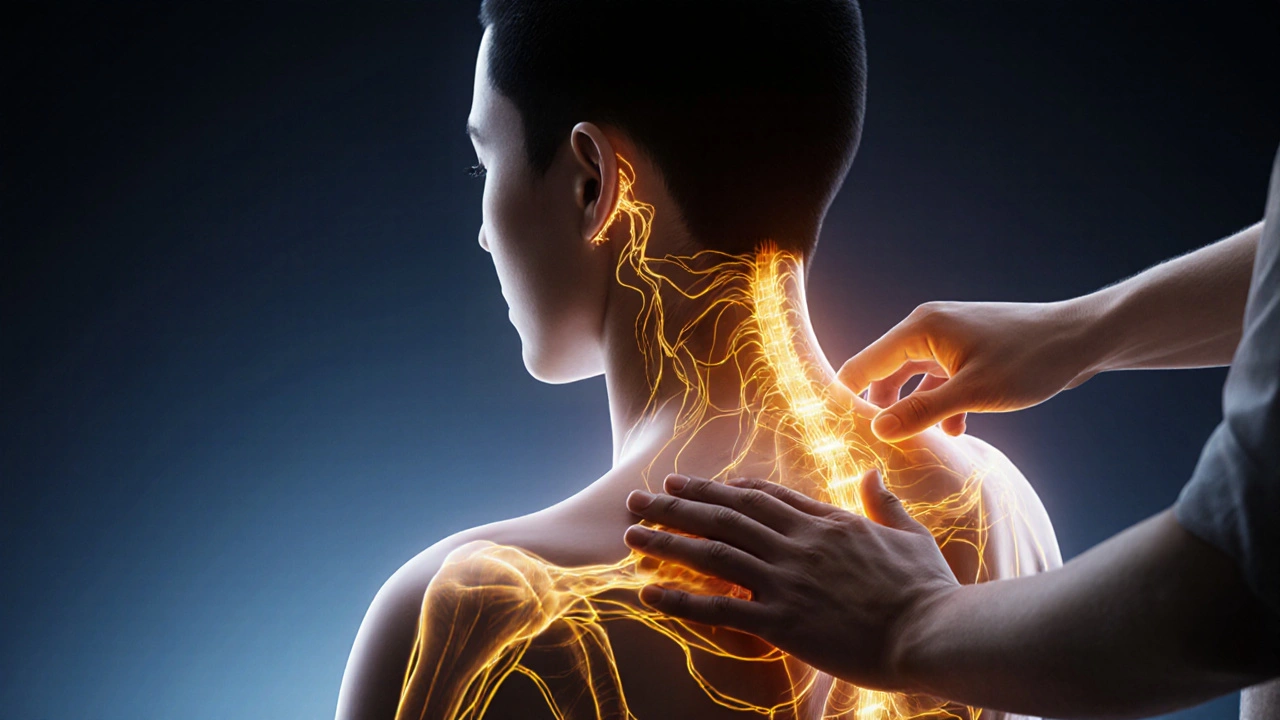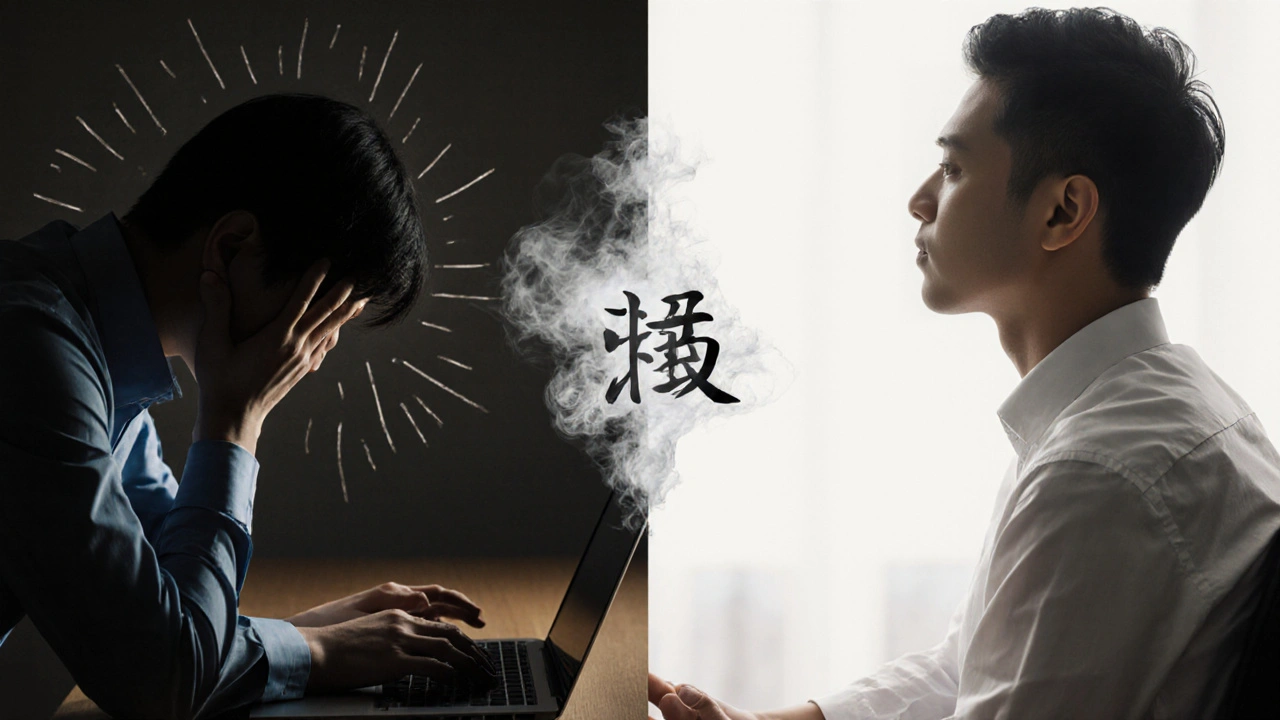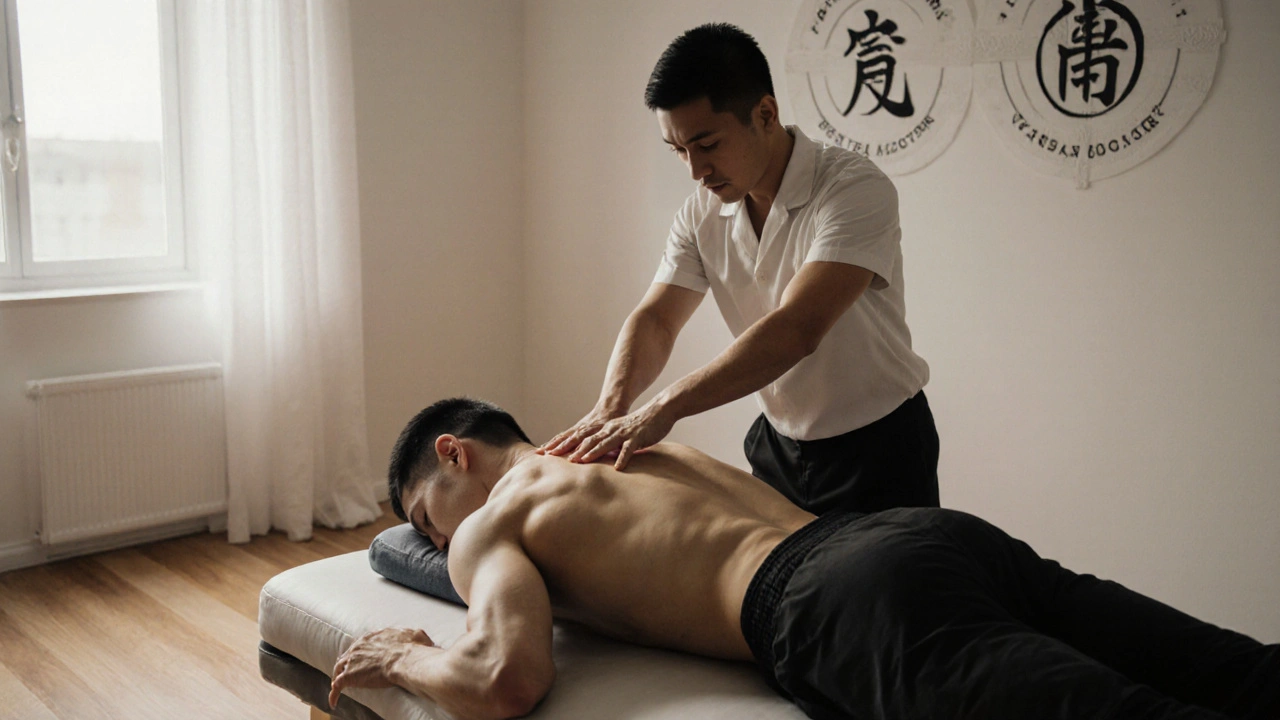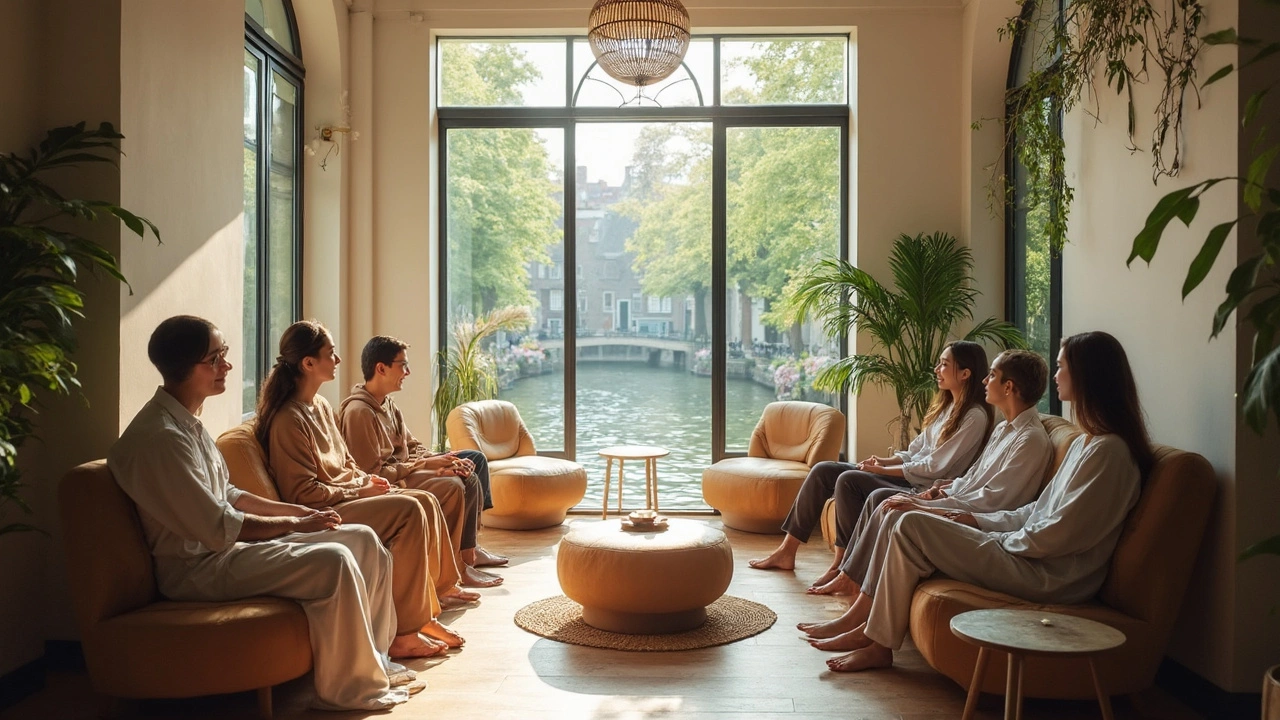Tuina Massage: Ancient Healing for Modern Stress and Tension

You’ve had a long week. Your shoulders are locked up, your neck feels like it’s carrying the weight of the world, and no amount of coffee or scrolling through memes has helped. What if there was a way to melt that tension-not with pills, not with fancy gadgets, but with hands that have been healing people for over 2,000 years?
What Is Tuina Massage?
Tuina massage is a hands-on therapy rooted in Traditional Chinese Medicine (TCM) that uses pressure, kneading, rolling, and stretching to restore balance in the body’s energy flow. Also known as Chinese therapeutic massage, it’s not just relaxation-it’s medicine in motion.
Unlike Swedish massage, which focuses on gentle strokes for relaxation, Tuina targets specific energy pathways called meridians. Practitioners use their palms, thumbs, fingers, and even elbows to apply deep, rhythmic pressure. It’s firm, intentional, and often feels like a deep tissue massage mixed with acupuncture-without the needles.
Think of your body like a city with traffic jams. Stress, injury, or poor posture causes blockages in your energy flow. Tuina doesn’t just smooth the surface-it clears the roads underneath. That’s why people who’ve tried it say they don’t just feel relaxed-they feel reconnected.
Why Tuina Works for Modern Stress
Modern life doesn’t give you time to slow down. You’re juggling work, family, screens, and endless notifications. Your nervous system is stuck in fight-or-flight mode. That’s where Tuina steps in.
Studies show that Tuina massage lowers cortisol levels-the stress hormone-by up to 25% after just one session. It also increases serotonin and dopamine, the body’s natural feel-good chemicals. But you don’t need a study to know this. You’ve felt it: that moment when your breath deepens, your jaw unclenches, and the tight knot between your shoulder blades finally lets go.
People in Amsterdam who’ve tried Tuina after long commutes, desk jobs, or sleepless nights with newborns often say the same thing: “I didn’t know my body could feel this light.”
How Tuina Differs from Other Massages
Not all massages are created equal. Here’s how Tuina stands out:
- Swedish massage is about relaxation with long, flowing strokes. Great for unwinding, but doesn’t fix underlying tension.
- Deep tissue massage targets muscle knots with intense pressure. Effective, but often painful and temporary.
- Thai massage involves stretching and yoga-like moves. Great for flexibility, but less focused on energy flow.
- Tuina massage combines pressure, movement, and energy work. It treats the root cause-not just the symptom.
Tuina doesn’t just release muscle tightness. It addresses why the tightness happened in the first place. Is it from anxiety? Poor sleep? A sedentary job? A skilled Tuina therapist will adjust their technique based on your unique pattern of imbalance.
What Happens During a Tuina Session?
You don’t need to undress fully. Most sessions are done over clothing-usually loose, comfortable clothes. You’ll lie on a massage table or sit in a chair, depending on what’s being treated.
The therapist starts by asking about your health, sleep, digestion, and stress levels. This isn’t small talk-they’re mapping your body’s energy. Then they begin: thumbs pressing along your spine, palms rolling over your shoulders, fingers pinching and releasing along your arms.
You might feel warmth, tingling, or even a slight ache-this is the energy moving. Some areas feel tender, others surprisingly soothing. A session lasts 45 to 75 minutes. You won’t feel “crushed.” You’ll feel released.
Afterward, you might feel a little tired, but in a good way-like you’ve just slept 8 hours. Many people report better sleep, clearer thinking, and less pain in the days that follow.

Who Can Benefit From Tuina?
Tuina isn’t just for people with chronic pain. It’s for anyone carrying invisible weight:
- Office workers with neck and upper back pain from staring at screens
- Parents juggling kids and exhaustion
- Students dealing with exam stress and poor posture
- Athletes recovering from strain or wanting to prevent injury
- People with anxiety or insomnia looking for natural relief
- Those with digestive issues-Tuina can stimulate the stomach and spleen meridians to improve digestion
It’s safe for most people, but not if you have open wounds, severe osteoporosis, or are in the first trimester of pregnancy without clearance from your doctor.
Where to Find Tuina in Amsterdam
Amsterdam has a growing number of clinics offering authentic Tuina. Look for practitioners trained in Traditional Chinese Medicine, preferably with certification from institutions like the European School of Traditional Chinese Medicine or those who studied in China.
Popular areas to find qualified therapists include De Pijp, Jordaan, and near the Vondelpark. Many offer sessions in quiet, minimalist studios with herbal steam or calming incense-no flashy signs, just calm energy.
Check reviews for mentions of “energy work,” “deep healing,” or “TCM-trained.” Avoid places that call it “Chinese relaxation massage” without mentioning meridians or TCM-it’s likely just a watered-down version.
What to Expect in Terms of Cost and Booking
A single Tuina session in Amsterdam typically costs between €65 and €95, depending on the therapist’s experience and location. Longer sessions (75-90 minutes) may run up to €110.
Many clinics offer package deals: 5 sessions for €300-€400. This is common because Tuina works best with consistency. Think of it like going to the gym-you wouldn’t expect results from one workout.
Booking is easy. Most therapists accept online reservations via their websites. Some even offer 15-minute free consultations to see if Tuina is right for you. Don’t be afraid to ask about their training background. A good practitioner will be happy to explain their approach.

Tuina vs. Acupuncture: Which Is Better for Stress?
Both are pillars of Traditional Chinese Medicine. But they work differently:
| Aspect | Tuina Massage | Acupuncture |
|---|---|---|
| Method | Manual pressure on meridians and points | Thin needles inserted into specific points |
| Duration of Session | 45-90 minutes | 30-60 minutes |
| Physical Sensation | Firm pressure, warmth, movement | Mild tingling, dull ache, no pain |
| Best For | Muscle tension, stiffness, circulation | Emotional imbalance, chronic anxiety, hormonal issues |
| Frequency Needed | Weekly or biweekly for 4-6 weeks | Weekly for 4-8 weeks, then maintenance |
| Aftercare | Drink water, rest, avoid cold | Same as Tuina |
Many people use both. Tuina clears the physical blockages; acupuncture calms the nervous system. Together, they’re a powerful combo.
Frequently Asked Questions
Is Tuina massage painful?
It shouldn’t be. Tuina uses firm pressure, but it’s not about pain. A good therapist adjusts pressure to your comfort level. If it hurts too much, speak up. The goal is release, not punishment.
How many sessions do I need to see results?
Most people notice a difference after 2-3 sessions. For lasting change-especially with chronic stress or pain-6 to 8 sessions over 4-6 weeks is typical. Think of it as retraining your body’s response to stress.
Can I do Tuina on myself?
You can try simple techniques-like pressing between your thumb and index finger for headaches, or rubbing your lower back in circles. But true Tuina requires knowledge of meridians and pressure points. Self-massage helps, but it’s not a replacement for professional treatment.
Is Tuina safe during pregnancy?
Yes-but only with a therapist trained in prenatal TCM. Certain points are avoided during pregnancy. Always inform your practitioner if you’re pregnant or trying to conceive.
Do I need to believe in energy for Tuina to work?
No. You don’t need to believe in Qi or meridians to feel the benefits. The physical effects-reduced muscle tension, improved circulation, lower stress hormones-are real and measurable. The energy model is just one way to explain what’s happening.
Ready to Let Go?
Stress doesn’t disappear because you wish it would. It fades when your body gets the signal it’s safe to relax. Tuina massage gives your nervous system that signal-without drugs, without gadgets, without hours of meditation.
It’s ancient. It’s simple. And in a world that never stops, it might be exactly what you’ve been missing.
Book your first session. Let your hands be the bridge between your tired body and your calm mind.



Ibrahim Ibn Dawood
November 7, 2025 AT 16:40Tuina is just acupuncture without needles, marketed as ‘ancient wisdom’ to justify €90 sessions. The ‘meridians’ aren’t real-no peer-reviewed study has ever mapped them anatomically. You’re paying for placebo and incense.
Mia Peronilla
November 9, 2025 AT 14:10i just tried tuina after reading this and… wow. my neck felt like it had been holding a cinderblock since 2019 and now? it’s like my spine remembered how to breathe. i didn’t believe in qi either but my body did. also i spelled ‘meridian’ wrong in my notes lol
lady october
November 10, 2025 AT 23:36Who funds these ‘TCM clinics’ in Amsterdam? Big Pharma hates natural remedies, right? That’s why they’re letting them operate-so people think they’re ‘healing’ while the real cure (pharmaceuticals) stays in demand. And don’t get me started on ‘herbal steam’-probably just lavender oil and a space heater. 🤔
Saul Stucchi
November 11, 2025 AT 17:14I’ve been to three different Tuina therapists in Portland, and honestly? The one who asked me about my childhood sleep patterns and my dog’s death changed my life. It’s not magic-it’s presence. They see you. Not just your tight shoulders. They hold space. And that? That’s rare. 🙏
Chase D
November 12, 2025 AT 06:01Okay but what if the ‘energy flow’ is just your nervous system calming down because someone touched you without trying to sell you something? 😮💨 Also, I saw a TikTok that said some ‘TCM’ clinics in Europe use needles disguised as ‘acupressure tools’-is that true? I’m not paranoid, I just read the comments. 🧠✨
Nina Khvibliani
November 12, 2025 AT 22:09It’s not massage. It’s alchemy. Your body is a storm of unspoken grief, caffeine crashes, and silent screams wrapped in muscle. Tuina doesn’t knead-it listens. It whispers back in warmth, in tingles, in the quiet sigh you didn’t know you’d been holding. I cried after my first session. Not from pain-from release. Like my bones remembered they were meant to be soft. 🌿💫